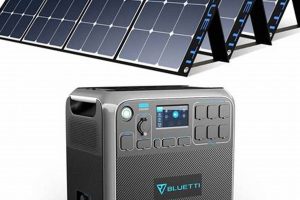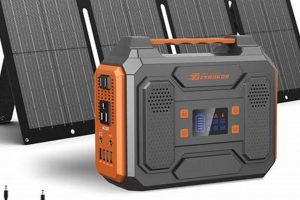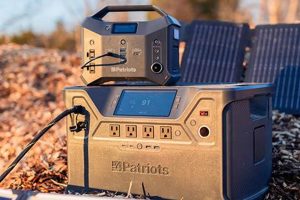A compact, self-contained power source utilizes photovoltaic panels to convert sunlight into electricity, storing it in an internal battery. This stored energy provides a readily available backup supply during power outages or in off-grid locations, capable of powering essential devices and appliances. An example would be a unit used to operate lights, small refrigerators, and electronic devices during a camping trip or a power disruption at home.
These devices offer a significant advantage in disaster preparedness and sustainable living. Their independence from fossil fuels makes them an environmentally sound choice, offering a clean and quiet alternative to conventional generators. Furthermore, advancements in battery technology and solar panel efficiency have increased their practicality and affordability, making them a viable option for a wider range of applications. The increasing awareness of environmental responsibility and the rising cost of traditional fuels have driven the development and adoption of these systems over recent years.
This discussion will further explore key aspects of these power solutions, including their various types, functionalities, selection criteria, and maintenance requirements, ultimately aiming to provide a comprehensive understanding of their role in modern power management.
Tips for Utilizing Solar Backup Generators
Optimizing the performance and lifespan of a solar backup generator requires careful consideration of several factors. The following tips provide guidance on selecting, operating, and maintaining these devices effectively.
Tip 1: Accurate Power Needs Assessment: Determine the wattage requirements of devices intended for backup power. This assessment ensures the generator can handle the anticipated load. Consulting appliance manuals or using a wattage meter can provide accurate measurements.
Tip 2: Appropriate Solar Panel Capacity: Choose a generator with sufficient solar panel capacity to recharge the battery efficiently within a reasonable timeframe. Consider the local climate and average sunlight hours.
Tip 3: Battery Capacity and Type: Evaluate battery capacity based on desired runtime and power needs. Different battery chemistries offer varying lifespans and performance characteristics. Research options like lithium-ion or lead-acid to determine the best fit.
Tip 4: Inverter Compatibility: Verify the inverter’s output waveform (pure sine wave or modified sine wave) to ensure compatibility with sensitive electronics. Pure sine wave inverters are generally preferred for devices like laptops and medical equipment.
Tip 5: Proper Charging Practices: Follow manufacturer guidelines for charging the generator. Avoid overcharging or completely depleting the battery, as this can shorten its lifespan.
Tip 6: Regular Maintenance: Periodically inspect the generator’s components, including the solar panels, battery, and wiring. Clean the solar panels to optimize sunlight absorption and check for any signs of damage or wear.
Tip 7: Safe Storage: When not in use, store the generator in a cool, dry place away from direct sunlight and extreme temperatures. Consult the manufacturer’s recommendations for specific storage guidelines.
Adhering to these guidelines ensures optimal performance, prolonged lifespan, and safe operation, maximizing the benefits of these valuable power solutions.
By understanding these crucial aspects, consumers can make informed decisions and confidently integrate these devices into their power management strategies.
1. Portability
Portability is a defining characteristic of these power solutions, directly influencing their usability and applicability. This feature allows users to readily move the generator to the optimal location for sunlight exposure, essential for efficient charging. Furthermore, portability enables these devices to serve as a versatile power source for various activities, ranging from camping and outdoor events to emergency home backup. This contrasts with traditional stationary generators, which offer limited mobility. Consider, for instance, a family using a portable solar backup generator during a camping trip to power lights and small appliances, highlighting the practical significance of portability in enabling off-grid power access.
The compact design and lightweight construction of many models contribute to their portability. This ease of transport makes them particularly valuable in disaster relief efforts, where rapid deployment of power is critical. Imagine a scenario where power lines are down after a storm; a portable solar generator can be readily transported to affected areas, providing essential power for first responders and residents. This exemplifies the critical role portability plays in emergency preparedness and response. Furthermore, the ability to easily relocate the generator throughout the day to follow the sun maximizes solar energy capture, particularly beneficial in areas with limited sunlight or during winter months.
In conclusion, portability significantly expands the potential applications of solar backup generators. This feature enhances their utility across diverse scenarios, from recreational activities to emergency situations. Understanding the implications of portability empowers users to effectively leverage these devices, optimizing their performance and maximizing their benefits in a range of practical applications. The integration of portability with other key features contributes to the overall value and appeal of these increasingly important power solutions.
2. Solar Charging
Solar charging forms the foundation of a portable solar backup generator’s operational capability, enabling sustainable and independent power generation. This core functionality distinguishes these devices from traditional fuel-powered generators, offering a clean and renewable energy source. Understanding the nuances of solar charging is essential for maximizing the effectiveness and lifespan of these power solutions.
- Photovoltaic Cell Technology:
Photovoltaic cells, the fundamental components of solar panels, convert sunlight directly into electricity. Crystalline silicon and thin-film technologies are commonly employed in portable solar generators. Crystalline silicon offers higher efficiency but is more fragile, while thin-film is flexible and lighter but less efficient. The efficiency and durability of these cells directly influence the charging rate and overall lifespan of the generator. For instance, a generator with high-efficiency monocrystalline silicon panels will charge faster in full sunlight compared to one with thin-film panels.
- Charging Rate and Sunlight Exposure:
The charging rate depends on factors like solar panel size, sunlight intensity, and panel angle relative to the sun. Optimal charging occurs when the panels are perpendicular to direct sunlight. Users can maximize charging efficiency by adjusting the panel angle throughout the day to track the sun’s movement. In regions with limited sunlight, larger panels or supplemental charging methods may be necessary to maintain adequate battery levels. For example, a generator used during winter months may require longer charging times due to reduced sunlight hours and intensity.
- Charge Controllers and Battery Management:
Charge controllers regulate the flow of electricity from the solar panels to the battery, preventing overcharging and damage. These controllers employ algorithms to optimize charging based on battery type and environmental conditions. Advanced Maximum Power Point Tracking (MPPT) controllers further enhance charging efficiency by dynamically adjusting to varying sunlight conditions. Effective charge control is crucial for prolonging battery life and ensuring safe operation. An improperly configured charge controller could lead to premature battery failure, significantly impacting the generator’s functionality.
- Environmental Factors and Efficiency:
Environmental factors such as temperature, cloud cover, and shading significantly affect solar charging performance. High temperatures can reduce panel efficiency, while cloud cover and shading obstruct sunlight, diminishing power output. Users should consider these factors when estimating charging times and ensure adequate sunlight exposure for optimal performance. For instance, a generator placed in a shaded area will charge significantly slower, potentially requiring relocation to a sunnier spot for effective charging.
These interconnected facets of solar charging directly influence the overall performance and usability of a portable solar backup generator. Understanding these elements empowers users to optimize charging strategies, maximize energy generation, and ensure the long-term reliability of their power solution. This knowledge enables informed decisions regarding panel selection, placement, and maintenance, contributing to a more effective and sustainable power management approach. By considering these factors, users can harness the full potential of solar energy to power their essential devices reliably and sustainably.
3. Backup Power
Backup power represents a critical function of portable solar backup generators, providing a crucial safety net during power outages. The ability to maintain essential services during grid failures underscores the practical significance of these devices. Cause and effect are directly linked: a power outage triggers the generator’s backup functionality, supplying electricity to connected devices. This capability offers significant advantages in various scenarios, from natural disasters to planned maintenance, safeguarding against disruptions to essential operations. For example, during a severe storm, a portable solar backup generator can power critical appliances like refrigerators, preserving food and medications, while also enabling communication through charged mobile devices. This highlights the direct impact of backup power availability on safety and well-being during emergencies.
The integration of solar charging enhances the backup power function by providing a sustainable and independent energy source. Unlike conventional generators that rely on finite fuel supplies, portable solar generators can replenish their energy reserves through sunlight, extending their operational capacity during prolonged outages. This self-sufficiency reduces reliance on external resources and minimizes environmental impact. Consider a scenario where a remote area experiences an extended grid failure; a portable solar generator can provide continuous power for essential services, such as medical equipment or water purification systems, demonstrating the practical value of solar-powered backup in maintaining critical infrastructure. This capability is particularly crucial in areas prone to power disruptions or lacking reliable grid access.
In conclusion, backup power functionality is an integral component of portable solar generators, ensuring continuity of essential services during grid failures. The integration of solar charging enhances this capability, providing a sustainable and independent power source. Understanding the practical significance of this functionality underscores the value of these devices in emergency preparedness, off-grid operations, and ensuring resilience in the face of power disruptions. Further exploration of specific applications and technological advancements will provide a more comprehensive understanding of the evolving role of portable solar backup generators in modern power management strategies. This understanding empowers individuals and communities to enhance their preparedness and resilience in an increasingly unpredictable energy landscape.
4. Generator Functionality
Generator functionality lies at the heart of a portable solar backup generator, providing a self-contained power source independent of the electrical grid. This core functionality allows operation of electrical devices and appliances in off-grid locations or during power outages. The cause-and-effect relationship is straightforward: demand for electricity triggers the generator component, converting stored energy into usable AC power. This capability is essential for various applications, from powering tools on a construction site to providing electricity during camping trips. For example, a portable solar backup generator can power essential medical equipment during a power outage in a healthcare setting, underscoring the practical significance of this functionality in critical situations.
Several factors influence the generator functionality of these devices, including power output, runtime, and inverter type. Power output, measured in watts, determines the number and type of devices the generator can handle simultaneously. Runtime, typically expressed in hours, indicates how long the generator can operate at a given load before requiring recharge. Inverter type significantly impacts the compatibility with different devices; pure sine wave inverters are generally preferred for sensitive electronics. Consider a scenario where a homeowner utilizes a portable solar backup generator during an extended power outage to operate a refrigerator, lighting, and a laptop. Understanding the generator’s power output, runtime, and inverter type becomes crucial for ensuring continuous operation of these essential devices. Matching generator specifications to specific power needs is vital for effective utilization.
The integration of solar charging differentiates portable solar backup generators from conventional fuel-powered generators. Solar charging provides a sustainable means of replenishing the generator’s energy reserves, reducing reliance on fossil fuels and minimizing environmental impact. This feature enhances the long-term viability of these devices, particularly in off-grid or emergency preparedness scenarios. Furthermore, advancements in battery technology and inverter efficiency continue to improve the performance and reliability of portable solar backup generators. These ongoing developments expand the practical applications of these devices, contributing to a more resilient and sustainable approach to power management. Understanding the core principles of generator functionality, coupled with an awareness of technological advancements, allows users to effectively leverage these power solutions and adapt to evolving energy needs.
5. Emergency Preparedness
Emergency preparedness relies heavily on access to reliable power, a critical need often disrupted during crises. Portable solar backup generators address this vulnerability, providing a crucial source of electricity when conventional power grids fail. The cause-and-effect relationship is clear: natural disasters or other emergencies disrupt power infrastructure, triggering the need for backup power solutions. These generators offer an immediate response, enabling the operation of essential devices and communication systems. For example, during a hurricane, a portable solar backup generator can power essential appliances like refrigerators for food preservation, radios for emergency broadcasts, and charging devices for communication, highlighting the importance of emergency preparedness as a driving factor behind the adoption of these generators. This capability bridges the gap between grid failure and access to essential power, directly impacting safety and well-being during critical periods.
Furthermore, the independence of portable solar backup generators from external fuel sources offers a significant advantage in emergency preparedness. Unlike traditional generators that require gasoline or propane, often scarce during emergencies, these devices rely on a readily available and renewable resource: sunlight. This self-sufficiency allows for sustained operation without the logistical challenges of fuel procurement and storage, particularly crucial in disaster-stricken areas. Consider a scenario where a remote community is cut off from supply lines after an earthquake; a portable solar backup generator can power essential communication equipment, enabling contact with rescue services and coordination of relief efforts. This capability underscores the practical significance of solar-powered backup in facilitating effective disaster response and recovery.
In conclusion, portable solar backup generators play a vital role in enhancing emergency preparedness strategies. Their ability to provide independent and sustainable power during grid failures addresses a critical vulnerability in crisis situations. Understanding the direct link between emergency preparedness and access to reliable power underscores the value of these devices in mitigating the impact of disasters and ensuring community resilience. Investing in portable solar backup generators contributes to a proactive approach to emergency preparedness, equipping individuals and communities with the tools necessary to navigate unforeseen events and maintain essential services during critical periods. This preparedness translates into enhanced safety, improved response capabilities, and a greater capacity to recover from emergencies effectively.
Frequently Asked Questions
This section addresses common inquiries regarding portable solar backup generators, providing concise and informative responses to facilitate informed decision-making.
Question 1: What differentiates a portable solar backup generator from a conventional gasoline generator?
Portable solar backup generators utilize solar energy to charge an internal battery, providing a clean and silent power source. Conventional gasoline generators rely on fossil fuels, producing emissions and noise. Solar generators offer a sustainable and environmentally friendly alternative, particularly valuable in off-grid or emergency scenarios.
Question 2: How is the battery capacity of a portable solar backup generator determined, and what does it signify?
Battery capacity is measured in watt-hours (Wh) and indicates the total amount of energy the battery can store. Higher capacity translates to longer runtime for connected devices. Selecting an appropriate capacity depends on the anticipated power demands and desired usage duration.
Question 3: What factors influence the charging time of a portable solar backup generator?
Charging time depends on solar panel size, sunlight intensity, and environmental conditions. Larger panels and direct sunlight exposure expedite charging. Cloud cover, shading, and lower sun angles can prolong charging times.
Question 4: Can sensitive electronic devices be safely powered by a portable solar backup generator?
Compatibility depends on the generator’s inverter type. Pure sine wave inverters are recommended for sensitive electronics like laptops, medical devices, and certain appliances, as they produce a cleaner power output, minimizing the risk of damage.
Question 5: What maintenance is required for a portable solar backup generator?
Regular maintenance includes keeping the solar panels clean for optimal sunlight absorption and periodically checking battery health. Consult the manufacturer’s guidelines for specific maintenance recommendations and schedules.
Question 6: What safety precautions should be observed when operating a portable solar backup generator?
Operate the generator in a well-ventilated area to prevent heat buildup. Avoid exposure to moisture and extreme temperatures. Follow manufacturer guidelines for safe handling and operation to prevent damage and ensure user safety.
Understanding these key aspects of portable solar backup generators empowers informed selection and effective utilization of these valuable power solutions.
The following section will delve into specific applications and case studies, further illustrating the practical benefits of these devices.
Conclusion
Portable solar backup generators represent a significant advancement in power management, offering a sustainable and resilient solution for various applications. This exploration has highlighted their key functionalities, including portable power generation, solar charging capabilities, backup power provision, and their critical role in emergency preparedness. The examination of core attributes such as portability, solar charging mechanisms, and generator functionality underscores their versatility and practicality. Furthermore, the discussion of emergency preparedness emphasizes their significance in mitigating the impact of power disruptions and ensuring access to essential services during critical periods.
The increasing demand for reliable and sustainable power solutions positions portable solar backup generators as a vital component of future energy strategies. Continued technological advancements promise further enhancements in efficiency, capacity, and affordability, expanding their accessibility and broadening their applications. Consideration of these devices represents a proactive approach to power management, fostering resilience, promoting sustainability, and ensuring preparedness in an evolving energy landscape.






